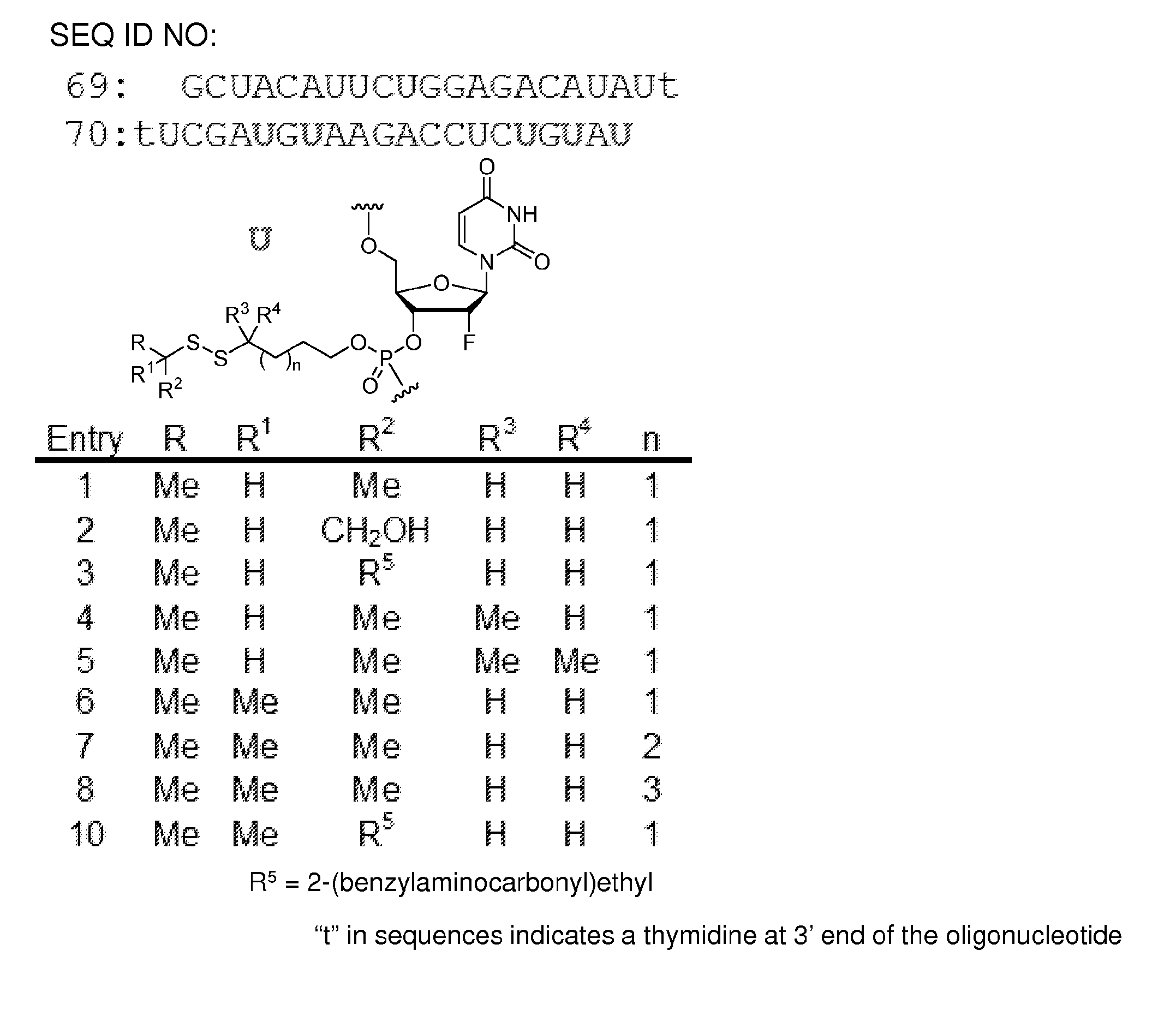Polynucleotide constructs having disulfide groups
a technology of disulfide groups and polynucleotides, which is applied in the field of compositions and methods of transfection of cells, can solve the problems of complexes generally toxic to cells, polynucleotides do not readily diffuse across cell membranes, and transfection reagents fail to achieve efficient delivery into many cell types, especially primary cells and hematopoietic cell lines
- Summary
- Abstract
- Description
- Claims
- Application Information
AI Technical Summary
Benefits of technology
Problems solved by technology
Method used
Image
Examples
example 1
Synthesis and Purification of the Nucleotides and Polynucleotides of the Invention
General Synthesis Procedure
[0550]The polynucleotide constructs of the invention can be prepared according to the generalized and specific methods and schemes described herein. For example, starting materials containing thiols underwent a reaction with 2,2′-dipyridyl disulfide affording the corresponding pyridyl disulfide compounds (e.g., see Scheme 1), which were then subjected to a reaction with nucleoside phosphordiamidites to generate nucleotide constructs of the invention (e.g., see Scheme 1). These nucleotide constructs were then used in standard oligonucleotide synthesis protocols to form polynucleotide constructs. These polynucleotide constructs were then deprotected and purified using HPLC.
Specific Syntheses of the Nucleotides of the Invention
[0551]Exemplary syntheses of nucleotides of the invention are described below.
Precursors
[0552]
[0553]To a solution of 4-Mecaptol-butanol (10.0 g, 94 mmol) ...
example 2
In Vitro Activity Assays
[0846]Polynucleotides targeting the luciferase gene (GL3) were synthesized and were used to generate the polynucleotide constructs having one or more disulfide linkages attached to internucleotide bridging groups (phosphotriesters) and / or terminal groups (phosphodiester or phosphotriester).
[0847]To assess the in vitro activity of these disulfide phosphotriesters, human ovarian SKOV-3 cells, stably expressing luciferase (GL3) were utilized. Cells were grown in McCoy's 5A culture medium (Life Technologies) supplemented with 10% fetal bovine serum (FBS), 100 μg / ml of streptomycin, and 100 U / ml of penicillin. Cells (1×104 / well) were plated in 96-well microtiter plates and incubated overnight at 37° C. under 5% CO2.
[0848]Control:
[0849]The control siRNAs targeting the luciferase gene or a non-targeting control gene were transfected into cells at the indicated concentrations (typically 0.01-30 nM) using lipofectamine RNAiMax (Life Technologies) according to the manu...
example 3
Cell Binding Experiments
[0857]Disulfide Phosphotriester Oligonucleotide-Cy3 Cell Binding General Protocol:
[0858]polynucleotide constructs of the invention containing disulfide groups linked to one or more internucleotide bridging groups and / or terminal groups were annealed to G2′ Mod-Cy3 (guide strand) at a final concentration of 10 mM.
[0859]Cell Treatment Setup:
[0860]40,000 cells were plated per well in a 48 well plate; cells were allowed to adhere overnight. Then, cells were washed once with 500 μl of PBS then 150 ul treatments were added (Note: for free folic acid samples, cells were treated with media containing 2.3 mM folic acid for 1 h prior to treatment). Cells were treated for 4 h; after 4 h, cells were washed once with PBS, trypsinized, and analyzed by flow cytometry for siRNA-Cy3 cell association.
[0861]Results of these experiments are shown in FIGS. 9A, 9B, 10A, 10B, 11A, and 11B. FIG. 9A shows dose curves for (Folate)3-siRNN-Cy3 conjugate binding to KB cell. FIG. 9B shows...
PUM
| Property | Measurement | Unit |
|---|---|---|
| Fraction | aaaaa | aaaaa |
| Fraction | aaaaa | aaaaa |
| Fraction | aaaaa | aaaaa |
Abstract
Description
Claims
Application Information
 Login to View More
Login to View More - R&D
- Intellectual Property
- Life Sciences
- Materials
- Tech Scout
- Unparalleled Data Quality
- Higher Quality Content
- 60% Fewer Hallucinations
Browse by: Latest US Patents, China's latest patents, Technical Efficacy Thesaurus, Application Domain, Technology Topic, Popular Technical Reports.
© 2025 PatSnap. All rights reserved.Legal|Privacy policy|Modern Slavery Act Transparency Statement|Sitemap|About US| Contact US: help@patsnap.com



